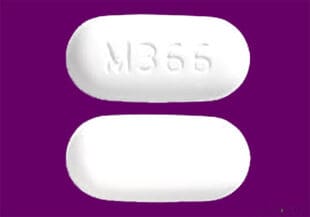M366 Pill
Content approved by
M366 refers to a prescription pill that belongs to the narcotic and analgesic category.
Each contains:
- 7.5 mg of hydrocodone
- 325 mg of acetaminophen
Together they potentiate one other.
Image:

| Product type: Human prescription drug Active ingredients: hydrocodone bitartrate and acetaminophen Uses: moderate to moderately severe pain relief Indications: for the management of moderate to moderately severe pain severe enough to require an opioid analgesic and for which alternative treatments are inadequate. Drug type: narcotic-analgesic Contraindications:Significant respiratory depression, acute or severe bronchial asthma. Patients who have previously exhibited hypersensitivity to either drug. Known hypersensitivity to other opioids who may exhibit cross-sensitivity to hydrocodone. Strength: 325 mg / 7.5 mg Prescription required: yes DEA schedule: schedule II controlled substance Warning: addiction, abuse, and misuse – hydrocodone is an opioid agonist Precautions: use with caution in elderly or debilitated patients, and those with severe impairment of hepatic or renal function, hypothyroidism, Addison’s disease, prostatic hypertrophy or urethral stricture. The usual precautions should be observed and the possibility of respiratory depression should be kept in mind administration: oral color: white shape: oblong size: 15.00 mm Manufacturer: Mallinckrodt Inc. Inactive ingredients: magnesium stearate, microcrystalline cellulose, corn starch, silicon dioxide, stearic acid (may vary) Storage: store between 68 and 77 degrees Fahrenheit, away from light. |
Absorption
Peak blood concentrations of this medication in most individuals are usually reached within one to two hours. However, the results may last only four to six hours, depending on factors such as metabolism, age, weight, and other individual characteristics.
Potential Side Effects
Aside from pain relief, they can induce feelings of drowsiness and euphoria. Common ones may include:
- Nausea
- Dizziness
- Mood swings
- Itching
- Difficulty concentrating
- Disorientation
The National Institutes of Health (NIH) provides documentation detailing numerous warnings about this medicine. Anyone prescribed them should disclose all their medications to their healthcare provider, including over-the-counter, dietary, and herbal supplements.
DEA Schedule
The Drug Enforcement Administration (DEA) Diversion Control Division categorizes this drug as a Schedule II, signifying a high potential for abuse.
It places strict restrictions on who can prescribe, take, and possess them. Individuals found with them without a valid prescription can face fines and potential jail time. Selling them is considered a felony, with long-term imprisonment as a possible penalty.
Addiction Abuse and Misuse
These tablets expose patients and other users to the risks of addiction, abuse, and misuse, which can lead to overdose and death. Moreover, the euphoric effect of the opioid component can lead to an unhealthy psychological dependence, with individuals taking more of the drug to replicate or maintain the euphoric feeling, increasing the risk of an overdose.
- Addiction can occur in patients appropriately prescribed these tablets. It can occur at recommended dosages and if the drug is misused or abused.
Most doctors limit the duration of this prescription to five to seven days due to the highly addictive nature of this med. Some patients may become dependent on it in a matter of days.
Respiratory Depression
Serious, life-threatening, or fatal respiratory depression may occur with use. Monitor for respiratory depression, especially during initiation or following a dose increase.
Overdose
Overdosing can have severe and potentially fatal consequences. The opioid content can suppress respiratory function, leading to breathing difficulties or even respiratory failure. Symptoms of overdose might include:
- extreme drowsiness
- muscle weakness
- confusion
- cold and clammy skin
- pinpoint pupils
- slow heart rate
- very slow breathing
- coma
Acetaminophen is safe in therapeutic doses but can cause acute liver failure if taken in excessive amounts, leading to symptoms like jaundice, confusion, and bleeding. Over time, such damage can be irreversible and life-threatening. Anyone suspected of overdosing should receive emergency medical attention immediately, as timely intervention can significantly impact the prognosis and potential for recovery.
Call 911 immediately if you suspect a medical problem
Interaction with Alcohol
Mixing them with alcohol can increase the risk of severe overdose symptoms, necessitating emergency medical treatment. Combining ethanol with them can amplify drowsiness, cognitive impairment, and dizziness. Moreover, it can cause a rapid drop in blood pressure, deep sedation, respiratory distress, coma, or even death.
If liquor is consumed excessively along with this medicine, the levels in the body may increase, leading to potential overdose side effects such as severe dizziness, slowed breathing, loss of consciousness, and even death. Furthermore, ethanol, or any substance containing it, can alter the metabolism of this medicine, potentially resulting in either lower or higher concentrations in the bloodstream.
image courtesy of drugs.com

